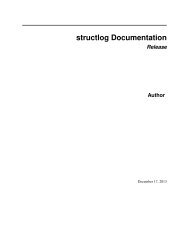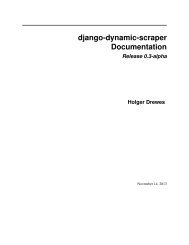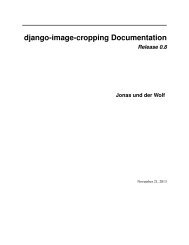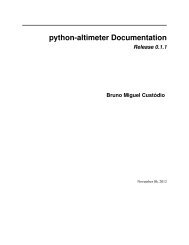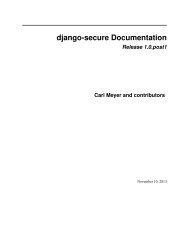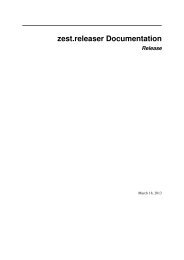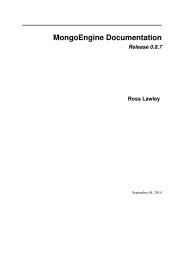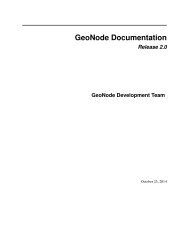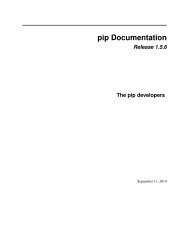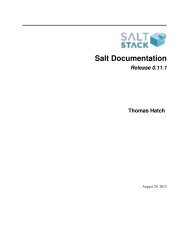py Documentation - Read the Docs
py Documentation - Read the Docs
py Documentation - Read the Docs
You also want an ePaper? Increase the reach of your titles
YUMPU automatically turns print PDFs into web optimized ePapers that Google loves.
<strong>py</strong> <strong>Documentation</strong>, Release 1.4.27.dev1<br />
In a sentence: positional arguments are child-tags and keyword-arguments are attributes.<br />
On a side note, you’ll see that <strong>the</strong> unicode-serializer supports a nice indentation style which keeps your generated html<br />
readable, basically through emulating <strong>py</strong>thon’s white space significance by putting closing-tags rightmost and almost<br />
invisible at first glance :-)<br />
6.2.2 basic example for generating html<br />
Consider this example:<br />
from <strong>py</strong>.xml import html<br />
# html namespace<br />
paras = "First Para", "Second para"<br />
doc = html.html(<br />
html.head(<br />
html.meta(name="Content-Type", value="text/html; charset=latin1")),<br />
html.body(<br />
[html.p(p) for p in paras]))<br />
print unicode(doc).encode(’latin1’)<br />
Again, tags are objects which contain tags and have attributes. More exactly, Tags inherit from <strong>the</strong> list type and thus<br />
can be manipulated as list objects. They additionally support a default way to represent <strong>the</strong>mselves as a serialized<br />
unicode object.<br />
If you happen to look at <strong>the</strong> <strong>py</strong>.xml implementation you’ll note that <strong>the</strong> tag/namespace implementation consumes some<br />
50 lines with ano<strong>the</strong>r 50 lines for <strong>the</strong> unicode serialization code.<br />
6.2.3 CSS-styling your html Tags<br />
One aspect where many of <strong>the</strong> huge <strong>py</strong>thon xml/html generation frameworks utterly fail is a clean and convenient<br />
integration of CSS styling. Often, developers are left alone with keeping CSS style definitions in sync with some style<br />
files represented as strings (often in a separate .css file). Not only is this hard to debug but <strong>the</strong> missing abstractions<br />
make it hard to modify <strong>the</strong> styling of your tags or to choose custom style representations (inline, html.head or external).<br />
Add <strong>the</strong> Browers usual tolerance of messyness and errors in Style references and welcome to hell, known as <strong>the</strong> domain<br />
of developing web applications :-)<br />
By contrast, consider this CSS styling example:<br />
class my(html):<br />
"my initial custom style"<br />
class body(html.body):<br />
style = html.Style(font_size = "120%")<br />
class h2(html.h2):<br />
style = html.Style(background = "grey")<br />
class p(html.p):<br />
style = html.Style(font_weight="bold")<br />
doc = my.html(<br />
my.head(),<br />
my.body(<br />
my.h2("hello world"),<br />
my.p("bold as bold can")<br />
)<br />
32 Chapter 6. <strong>py</strong>.xml: simple <strong>py</strong>thonic xml/html file generation



